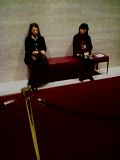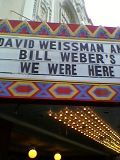 Tuesday night, at the invitation of a friend, I attended the Members' Preview for the San Francisco International Film Festival. It was held in the beautifully appointed Letterman Digital Arts Center, the home of Lucas Arts in the Presidio. I felt privileged just to be inside the lobby, with its Mission style furniture, Star Wars figures & vintage movie posters. The place exudes a warm aura of wealth. About 400 members of the San Francisco Film Society attended the 1st of 2 identical presentations by Executive Director Graham Leggat & festival programmers. The event was similar to the morning's press conference. Mr. Leggat even repeated his self-satirizing introduction. However, the members got to see brief clips from about 25 films, grouped by category. After each group of clips there was a short discussion.
Tuesday night, at the invitation of a friend, I attended the Members' Preview for the San Francisco International Film Festival. It was held in the beautifully appointed Letterman Digital Arts Center, the home of Lucas Arts in the Presidio. I felt privileged just to be inside the lobby, with its Mission style furniture, Star Wars figures & vintage movie posters. The place exudes a warm aura of wealth. About 400 members of the San Francisco Film Society attended the 1st of 2 identical presentations by Executive Director Graham Leggat & festival programmers. The event was similar to the morning's press conference. Mr. Leggat even repeated his self-satirizing introduction. However, the members got to see brief clips from about 25 films, grouped by category. After each group of clips there was a short discussion.The trailer for Beginners, starring Ewan McGregor, Christopher Plummer & a dog with his own subtitles, confirms that the movie is adorable & heart-warming. The Selling looks like an enjoyable parody of haunted house movies. Stake Land is a grizzly horror film. Le Quattro Volte appears to be a beautifully photographed treatise about man as an animal in nature. Though the clip we saw has a meaningful voice-over, the programmers assured us that the movie is mostly wordless. The Green Wave is a mash-up of overly-earnest voice-over, amateur video & crude animation. The aerial photography & evocative shots of abandoned neighborhoods made me want to see Detroit Wild City. I had no idea what to make of the clip from Chantrapas, which was a tracking shot of a man hesitantly walking down a street populated with circus-like characters. The Mill & the Cross is an arty, artificial CGI construction.
During the Q & A, a woman complained to Mr. Leggat about too-tight scheduling of specific weekday afternoon films, making it not worthwhile to take a day off work for the festival. Mr. Leggat called her comment "niggling," she called him "rude", & they had a tense exchange which ended when Mr. Leggat moved brusquely to another question. After the screening, my friend & I attended the wine & cheese reception in another building about a 5 minute walk away. My friend, a SFFS member for several years, observed less refreshments than in previous years.
§ SFFS Members Night
San Francisco International Film Festival 54
Tuesday, March 29
Letterman Digital Arts Center, The Presidio





















